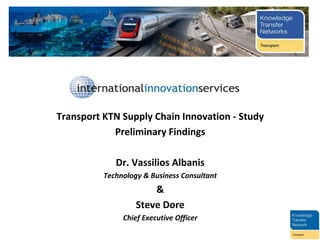Ktn Innovate 10 121010 Final
- 1. Transport KTN Supply Chain Innovation - Study Preliminary Findings Dr. Vassilios Albanis Technology & Business Consultant & Steve Dore Chief Executive Officer
- 2. ? Review the supply chain operations in three sectors ¨C Rail, Marine and Automotive ? Identify trends and drivers across the three sectors ? Investigate the key issues and challenges in the supply chain ? Review innovation practices in supply chain companies ? Assess the potential for adoption of market disruptive innovation practices Aim of Research Competitive supply chain
- 3. Sustainable Supply Chain Cross Cutting Themes ¨C Integrated approach across all sectors OEM TIER 1 TIER 2 TIER 2 TIER 3 TIER 3 TIER 1 TIER 2 ? Environment ? Economy ? Technology ? Society Sustainable and innovative practice to ensure that the future supply chain grows and remains competitive
- 4. ? Economic ¨C profitability, competitiveness, growth ? Environmental ¨C reduction of emissions, renewable energy, drain of resources ? Technological ¨C emerging technologies, new manufacturing processes, innovation, infrastructure, capacity ? Social ¨C customer focus, flexible working, changing demographics, security Trends and Drivers Innovative thinking leads to sustainable growth ? Sustainable growth ¨C ˇ°Rich and greenˇ± vs ˇ°poor and dirtyˇ± ? Re-assess current practices ? Facilitate growth with a minimum environmental footprint ? Proactive and adopt innovative practices
- 5. ? Globalisation ¨C complex market, price sensitive ? Market shifts ¨C demand fluctuation ? Risk mitigation ¨C end to end management ? Conservative ¨C slow adoption of emerging technologies ? Cost driven ¨C downward cost pressure Findings Incremental Innovation ¨C Disruptive Innovation ? Risk averse market ? Fragmented benchmarking models ? Favours incremental innovation instead of disruptive innovation
- 6. Companies are seeking to grow.... ? 84% companies are seeking to grow ? 65% to grow through new products ? 63% through introducing new services ? The rest through mergers and acquisitions Actively seeking to grow
- 7. ..and the rewards are very high for innovators.... 4X the revenue
- 8. ...but they are constrained by weaknesses in their innovation processes.... ? Innovation decisions ˇ®ad-hocˇŻ ¨C Formal organisation 77% - 23% ? Identifying ˇ®breakthroughˇŻ technologies 70% ? Picking winners & prioritising projects 70% ? Lack of formal commercialisation processes 61% ? Difficulties prototyping 44% Lacking simple processes & access to facilities
- 9. ....which leads to companies becoming risk averse focussing on incremental innovation.... Because they: ? CanˇŻt identify and measure innovation performance 70% ? 70+ metrics ? Innovation not part of corporate strategy 70% ? leading toˇ ? Difficulty in securing human and financial resources, and ? Poor internal collaborations Risk averse with innovation marginalised
- 10. ...and they then focus on incremental innovation... ? Companies recognise that they are poor at the generation of ˇ®breakthroughˇŻ ideas ? Poor at external collaborations e.g. Universities ? Automotive Sector 2008 ? 3,300 businesses - ?10.2bn VA ? 384,000 jobs ? add breakthrough innovation gives ?1.326bn additional GVA ? 50,000 jobs Breakthrough technologies = ????ˇŻs growth
- 11. Summary ? Dominant trend ¨C Cost reduction ? Sustainability compliance encouraged ? Emphasis on incremental innovation ? Breakthrough innovation ¨C More profitable ideas ? 70% of companies lack organisation & processes Recommendations ? Provide supply chain innovation audit benchmark ? Deliver appropriate processes, show-how & tools ? Platform for collaborative development Summary & Recommendations











